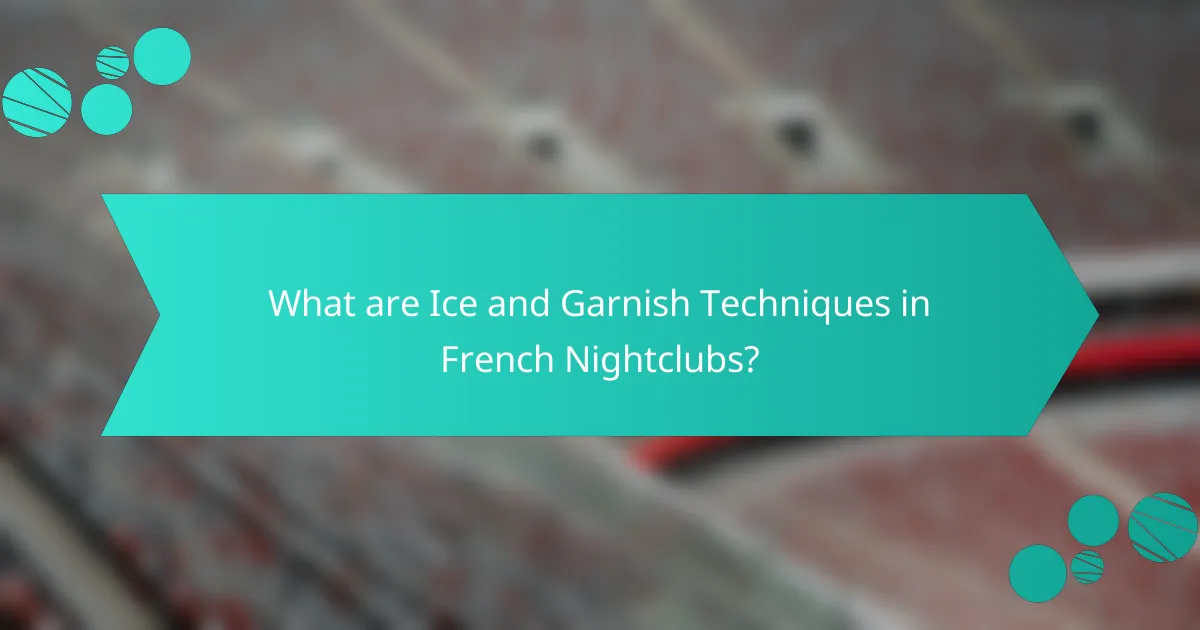Ice and garnish techniques are essential elements in the cocktail culture of French nightclubs, significantly enhancing the presentation and sensory experience of beverages. Various forms of ice, including crushed, cubed, and large blocks, are employed to maintain optimal drink temperature and visual appeal. Garnishes such as citrus peels, herbs, and edible flowers not only add aesthetic value but also enrich flavor complexity. Best practices for implementing these techniques include using high-quality ice, fresh seasonal garnishes, and precise cutting methods to ensure uniformity. By focusing on these aspects, nightclubs can elevate the guest experience and reinforce their brand image through visually appealing and flavorful drinks.

What are Ice and Garnish Techniques in French Nightclubs?
Ice and garnish techniques in French nightclubs involve specific methods to enhance the presentation and experience of beverages. Ice is often used in various forms, such as crushed, cubed, or large blocks, to maintain optimal drink temperature. Garnishes like citrus peels, herbs, or edible flowers add visual appeal and flavor complexity. These techniques are integral to cocktail culture in French nightclubs, elevating the overall aesthetic and sensory experience. The emphasis on presentation aligns with the French tradition of culinary artistry, where visual elements are as important as taste.
How do Ice and Garnish Techniques enhance the nightlife experience?
Ice and garnish techniques enhance the nightlife experience by elevating the visual appeal and taste of beverages. These techniques create a more engaging atmosphere for patrons. Ice can be shaped into unique forms, such as spheres or cubes, which not only chill drinks but also serve as a decorative element. Garnishes, like herbs or fruit, add vibrant colors and enticing aromas to cocktails.
Research indicates that visually appealing drinks increase customer satisfaction and encourage social interaction. According to a study published in the Journal of Hospitality and Tourism Research, aesthetically pleasing presentations lead to higher perceived value among consumers. Therefore, effective use of ice and garnishes can significantly improve the overall ambiance in nightlife settings.
What role does ice play in drink presentation and temperature?
Ice serves a critical role in drink presentation and temperature. It enhances the aesthetic appeal of beverages. Ice contributes to a visually appealing drink by adding texture and dimension. The presence of ice can make cocktails look more refreshing and inviting.
In terms of temperature, ice is essential for chilling drinks. It keeps beverages cold, preventing them from warming quickly. This is particularly important in social settings like nightclubs. Studies show that drinks served at lower temperatures are often perceived as more enjoyable.
Additionally, ice dilutes drinks gradually, which can enhance flavor profiles over time. This balance of presentation and temperature makes ice a vital element in cocktail culture.
How do garnishes contribute to the visual appeal of cocktails?
Garnishes enhance the visual appeal of cocktails by adding color, texture, and creativity. They provide contrast against the drink’s base, making it more eye-catching. For example, a bright citrus twist on a dark cocktail can create a striking visual effect. Edible flowers, herbs, or fruit slices can also elevate the presentation. Research indicates that visually appealing drinks can increase customer satisfaction and consumption. A study published in the Journal of Food Science found that aesthetics significantly influence perception of taste. Thus, garnishes play a crucial role in cocktail presentation and overall enjoyment.
What types of ice are commonly used in French nightclubs?
French nightclubs commonly use crushed ice and large ice cubes. Crushed ice is favored for cocktails as it chills drinks quickly. Large ice cubes are used in premium spirits to minimize dilution. These types of ice enhance the overall drinking experience. Crushed ice adds texture and visual appeal to cocktails. Large cubes maintain the integrity of high-quality liquors. The choice of ice impacts the presentation and taste of beverages served in nightclubs.
What are the different shapes and sizes of ice used in cocktails?
The different shapes and sizes of ice used in cocktails include cubes, spheres, and shards. Ice cubes are the most common form and typically measure about 1 inch on each side. They melt slowly, making them ideal for drinks that require dilution over time. Ice spheres are larger, usually around 2 inches in diameter, and provide a striking visual appeal while also melting slowly. Ice shards or crushed ice are smaller pieces that chill drinks quickly but dilute them faster. Each shape serves a specific purpose in cocktail preparation, influencing both temperature and dilution rates. These variations enhance the overall drinking experience by impacting flavor and presentation.
How does the type of ice affect the dilution and flavor of drinks?
The type of ice significantly affects the dilution and flavor of drinks. Larger ice cubes melt more slowly than smaller ones. This results in less dilution over time. Consequently, drinks maintain their intended flavor profile longer. Crushed ice, however, has a larger surface area. It melts faster, leading to quicker dilution. This can alter the taste of the drink more rapidly. Additionally, the texture of the ice can impact the mouthfeel of the drink. For example, large cubes provide a different experience compared to crushed ice. Overall, the choice of ice directly influences both the dilution rate and the flavor experience of beverages.
What types of garnishes are popular in French nightclubs?
Popular garnishes in French nightclubs include citrus twists, fresh herbs, and edible flowers. Citrus twists, such as lemon or orange peels, add a vibrant touch to cocktails. Fresh herbs like mint and basil enhance the aroma and flavor profile of drinks. Edible flowers, such as violets or nasturtiums, provide a visually appealing element. These garnishes are often used to elevate the presentation of beverages. They contribute to the overall sensory experience in nightlife settings. The use of these garnishes aligns with French culinary traditions, emphasizing aesthetics and flavor.
What are the most common garnishes used in cocktails?
Common garnishes used in cocktails include citrus slices, herbs, and berries. Citrus slices, such as lemon or lime, add brightness and acidity. Fresh herbs like mint or basil provide aroma and flavor. Berries, such as raspberries or blueberries, offer a pop of color and sweetness. Olives and cherries are also popular for their distinct taste and visual appeal. These garnishes enhance the cocktail experience by adding flavor, aroma, and aesthetic value.
How do garnishes vary based on cocktail types and themes?
Garnishes vary significantly based on cocktail types and themes. For classic cocktails, garnishes like citrus twists or olives are common. These add flavor and visual appeal. Fruit-based cocktails often feature fresh fruit slices or berries as garnishes. This enhances the drink’s fruity theme.
In tiki cocktails, tropical garnishes such as pineapple leaves or orchids are used. These reflect the exotic nature of the drink. For themed cocktails, unique garnishes are tailored to the occasion. For example, Halloween cocktails might use gummy worms or candy eyes.
The choice of garnish can also align with the cocktail’s color and ingredients. Brightly colored drinks typically feature contrasting garnishes for visual impact. Overall, garnishes are essential for enhancing both the flavor and presentation of cocktails.

How do Ice and Garnish Techniques impact drink aesthetics?
Ice and garnish techniques significantly enhance drink aesthetics. Ice can be shaped, sized, and textured to create visual appeal. Clear ice, for example, looks more refined than cloudy ice. Garnishes, such as herbs or fruits, add color and contrast to drinks. They also provide a sensory element that engages the drinker. The arrangement of garnishes can influence the perceived complexity of the drink. Studies show that visually appealing drinks are often perceived as more flavorful. This relationship between aesthetics and taste perception highlights the importance of presentation in mixology.
Why is visual appeal important in cocktail presentation?
Visual appeal is crucial in cocktail presentation because it enhances the overall drinking experience. A well-presented cocktail attracts attention and stimulates interest. Studies show that visually appealing drinks can increase perceived taste and enjoyment. For example, research indicates that colors and garnishes can influence consumer preferences. A cocktail that looks good is more likely to be shared on social media, increasing its visibility. This social sharing can lead to higher sales in bars and clubs. In summary, visual appeal directly impacts customer satisfaction and business success in the cocktail industry.
How do colors and textures from ice and garnishes enhance drinks?
Colors and textures from ice and garnishes enhance drinks by creating visual appeal and stimulating sensory experiences. Bright colors from garnishes like fruits or herbs attract attention and can influence mood. Textures, such as the smoothness of ice or the crispness of fresh herbs, add depth to the drinking experience. For example, crushed ice provides a different mouthfeel compared to cubed ice. The combination of colors and textures can also signal the flavor profile of the drink. A vibrant cocktail with a citrus garnish suggests freshness and zest. Studies show that visual elements can impact taste perception, making drinks more enjoyable. Therefore, the aesthetic aspects of ice and garnishes play a crucial role in enhancing the overall drinking experience.
What psychological effects do visually appealing drinks have on patrons?
Visually appealing drinks can enhance patrons’ enjoyment and perception of their experience. Attractive presentation can lead to increased anticipation and satisfaction. Research indicates that aesthetic appeal influences taste perception and overall enjoyment. A study by Spence et al. (2016) highlights that visual elements can enhance flavor perception. Patrons may also associate beautifully crafted drinks with higher quality and value. This association can lead to increased willingness to pay more for visually appealing options. Additionally, visually striking drinks can encourage social sharing on platforms like Instagram, further enhancing the overall experience.
How can Ice and Garnish Techniques be innovatively applied?
Ice and garnish techniques can be innovatively applied by using unique shapes and colors to enhance visual appeal. Ice can be molded into custom shapes, such as spheres or geometric designs, to create striking presentations. Flavored ice cubes can infuse beverages with additional taste, elevating the overall drinking experience. Garnishes can be made from edible flowers, herbs, or fruits, adding vibrant colors and aromas. Layering different types of garnishes can create depth in presentation. Innovative combinations of ice and garnishes can transform classic cocktails into artistic creations. The use of smoke-infused ice can add a dramatic effect to drinks. These techniques not only enhance aesthetics but also engage patrons, making the drinking experience more memorable.
What are some creative ways to use ice in cocktails?
Creative ways to use ice in cocktails include crafting ice spheres and incorporating flavored ice cubes. Ice spheres melt slowly, preventing dilution while enhancing presentation. Flavored ice cubes can infuse cocktails with additional taste as they melt. Another method is using crushed ice for texture and visual appeal. Layering different types of ice, such as clear and colored, creates striking visual contrasts. Additionally, using ice molds in unique shapes can elevate the cocktail’s aesthetic. These techniques enhance both the drinking experience and the cocktail’s overall presentation.
How can garnishes be customized to reflect seasonal themes?
Garnishes can be customized to reflect seasonal themes by using ingredients that are in season. For example, spring garnishes may include fresh herbs like basil or mint. Summer garnishes could feature colorful fruits such as berries or citrus slices. Autumn garnishes often incorporate seasonal vegetables like squash or root vegetables. Winter garnishes might utilize dried fruits or spices like cinnamon. This customization enhances the visual appeal and flavor profile of drinks. Seasonal garnishes also align with local sourcing practices, promoting freshness and sustainability. Utilizing seasonal ingredients ensures that garnishes are vibrant and relevant to the time of year.

What are best practices for using Ice and Garnish Techniques in French nightclubs?
Best practices for using ice and garnish techniques in French nightclubs include selecting high-quality ice and fresh garnishes. Clear ice cubes enhance visual appeal and slow dilution. Properly chilled glasses improve drink presentation and temperature. Using seasonal garnishes adds freshness and relevance to the menu. Precise cutting techniques for garnishes ensure uniformity and aesthetic appeal. Placing garnishes thoughtfully can elevate the drink’s overall look. Regularly updating garnish options keeps the menu dynamic and engaging. Following these practices enhances the guest experience and supports the nightclub’s brand image.
How can bartenders effectively incorporate ice and garnishes into their service?
Bartenders can effectively incorporate ice and garnishes by understanding their roles in drink presentation and temperature control. Ice serves to chill beverages quickly and maintain their temperature. Bartenders should use clear, clean ice to enhance visual appeal. They can also use various ice shapes, such as cubes or spheres, to match the drink’s style.
Garnishes add flavor and aesthetic value. Common garnishes include citrus twists, herbs, and edible flowers. Bartenders should select garnishes that complement the drink’s ingredients. Proper placement of garnishes is essential; they should be visible and accessible.
Research shows that visually appealing drinks can increase customer satisfaction and sales. A study by the Journal of Hospitality and Tourism Research found that presentation significantly influences consumer choice. Therefore, bartenders should prioritize both ice and garnishes to enhance the overall drinking experience.
What tips can improve the efficiency of ice handling in busy environments?
Use insulated ice bins to maintain temperature and reduce melting. This keeps ice solid for longer periods. Implement a clear workflow for ice retrieval. Assign specific staff roles to handle ice efficiently. Train staff on quick and safe ice handling techniques. Utilize ice scoops instead of hands to prevent contamination. Schedule regular ice replenishment to avoid shortages during peak times. Consider using ice machines for faster production in high-demand situations. These practices can significantly enhance ice handling efficiency in busy environments.
How can bartenders ensure garnishes remain fresh and appealing?
Bartenders can ensure garnishes remain fresh and appealing by using proper storage techniques. They should store garnishes in a cool, dry place to prevent wilting. Refrigeration can extend the freshness of herbs and fruits. Additionally, bartenders should use airtight containers to minimize exposure to air. Frequent rotation of garnishes helps maintain quality. Using fresh garnishes daily ensures better visual appeal. Proper hydration of garnishes, such as soaking herbs in water, can enhance their appearance. Studies show that fresh garnishes can increase customer satisfaction by up to 30%.
What common mistakes should be avoided with Ice and Garnish Techniques?
Common mistakes to avoid with ice and garnish techniques include using insufficient ice, which can lead to diluted drinks. Overfilling glassware with ice can obstruct the drink’s presentation. Using inappropriate garnishes that do not complement the drink’s flavor can detract from the overall experience. Failing to properly prepare garnishes, such as not washing or cutting them correctly, can affect hygiene and aesthetics. Lastly, neglecting to consider the drink’s temperature can result in an unbalanced flavor profile. These mistakes can undermine the quality of cocktails served in French nightclubs.
How can improper ice usage affect the overall drink quality?
Improper ice usage can significantly degrade the overall drink quality. Using ice that is too small can cause drinks to dilute quickly. This dilution leads to a loss of flavor intensity. Conversely, using ice that is too large can result in insufficient cooling. Insufficient cooling may leave drinks at an undesirable temperature. Additionally, dirty or contaminated ice can introduce unwanted flavors or bacteria. This contamination can pose health risks to consumers. Proper ice usage is essential for maintaining the intended taste and presentation of cocktails. Studies show that the right ice size and cleanliness enhance the sensory experience of beverages.
What are the pitfalls of using uncoordinated garnishes in cocktails?
Uncoordinated garnishes in cocktails can lead to a disjointed flavor profile. This inconsistency can confuse the drinker and detract from the overall experience. Additionally, mismatched garnishes may clash visually, reducing the aesthetic appeal. A cocktail’s presentation is crucial in upscale environments, such as French nightclubs. Poor garnishing can signal a lack of attention to detail. This can negatively affect the establishment’s reputation. Furthermore, uncoordinated garnishes may overwhelm the primary flavors of the cocktail. This can result in an unbalanced drink that fails to satisfy. Ultimately, the use of uncoordinated garnishes undermines the craft of cocktail making.
Ice and garnish techniques are essential elements in the cocktail culture of French nightclubs, enhancing both beverage presentation and sensory experience. This article explores the various types of ice, such as crushed and cubed, and their impact on drink temperature and aesthetics. It also examines popular garnishes, including citrus twists and fresh herbs, and their role in elevating the visual appeal and flavor profile of cocktails. Best practices for bartenders, common mistakes to avoid, and innovative applications of these techniques are discussed to improve customer satisfaction and overall drinking experience.